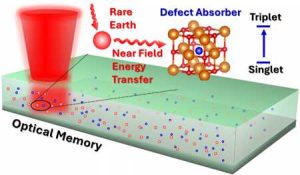From Argonne and University of Chicago, Quantum Research Paves Way Toward Efficient Ultra-High-Density Optical Memory Storage
Computations reveal promising pathway to exceed current limitation on storage.
This is a Press Release edited by StorageNewsletter.com on October 8, 2024 at 2:01 pmBy Sarah C.P. Williams, The University of Chicago , Pritzker School of Molecular Engineering
As our digital world generates massive amounts of data – more than 2 quintillion bytes of new content each day – yesterday’s storage technologies are quickly reaching their limits. Optical memory devices, which use light to read and write data, offer the potential of durable, fast and energy-efficient storage.
Researchers at Argonne and the University of Chicago combined classical physics with quantum modeling to show how rare-earth elements (red dots) and defects (blue dots) within solids can interact to store optically encoded classical data.
(Image courtesy: Galli Group.)
Now, researchers at the University of Chicago Pritzker School of Molecular Engineering (PME) and the U.S. Department of Energy’s (DOE) Argonne National Laboratory have proposed a new type of memory, in which optical data is transferred from a rare earth element embedded within a solid material to a nearby quantum defect. Their analysis of how such a technology could work was published in Physical Review Research.
“We worked out the basic physics behind how the transfer of energy between defects could underlie an incredibly efficient optical storage method,” said Giulia Galli, Liew Family professor, UChicago PME and Argonne senior scientist. “This research illustrates the importance of exploring first-principles and quantum mechanical theories to illuminate new, emerging technologies.”
Most optical memory storage methods developed in the past, including CDs and DVDs, are limited by the diffraction limit of light. A single data point cannot be smaller than the wavelength of the laser writing and reading the data. In the new work, the researchers proposed boosting the bit density of optical storage by embedding many rare-earth emitters within the material. By using slightly different wavelengths of light – an approach known as wavelength multiplexing – they hypothesized that these emitters could hold more data within the same area.
To show the feasibility of the approach, Galli and her colleagues 1st studied the physics requirements necessary for efficient and dense optical storage. They created models of a theoretical material interspersed with atoms of narrow band rare-earth emitters. These atoms absorb light and re-emit that light at specific, narrow wavelengths. The researchers showed how this narrow wavelength light could then be captured by a nearby quantum defect.
“This research illustrates the importance of exploring first-principles and quantum mechanical theories to illuminate new, emerging technologies,” said Galli
The predictions of the study were obtained by combining first-principles electronic structure theories to map the absorbing states of the defects, with quantum mechanical theories to model the propagation of light at the nanometer-scale. By developing such novel theoretical models, the team was able to better understand the rules governing how the energy is moved between the emitters and the defects, as well as how the defects store the captured energy.
“We wanted to develop the necessary theory to predict how energy transfer between emitters and defects work,” said Swarnabha Chattaraj, postdoctoral research fellow, Argonne. “That theory then allowed us to figure out the design rules for potentially developing new optical memories.”
While scientists have a good understanding of how quantum defects in a solid material typically interact with light, they had not previously studied how their behavior changes when the light comes from an incredibly close source, such as the narrow band rare-earth emitters embedded just a few nanometers away. “This kind of near-field energy transfer is thought to follow different symmetry rules than more commonly known far-field processes,” said Supratik Guha, Argonne senior scientist, advisor to Argonne’s Physical Sciences and Engineering Directorate, and PME professor.
Indeed, the group discovered that when the quantum defects absorbed the narrow band of energy from the nearby atoms, they not only became excited from their ground state, but also flipped their spin state. This spin state transition is hard to reverse, suggesting that these defects could store data for long periods of time. In addition, because of the smaller wavelengths of light emitted by the narrow band rare-earth emitters, as well as the tiny size of the defects, the system could provide a denser data storage method than other optical approaches.
“To start applying this to developing optical memory, we still need to answer additional basic questions about how long this excited state remains and how we read out the data,” said Chattaraj. “But understanding this near-field energy transfer process is a huge first step.”
This work was funded by the DOE Office of Science for support of microelectronics research.
Article: First-principles investigation of near-field energy transfer between localized quantum emitters in solids
Physical Review Research has published an article written by Swarnabha Chattaraj, Materials Science Division, Argonne National Laboratory, Lemont, Illinois 60439, USA, Supratik Guha, and Giulia Galli, Materials Science Division, Argonne National Laboratory, Lemont, Illinois 60439, USA, and Pritzker School cf Molecular Engineering, University cf Chicago, Chicago, Illinois 60637, USA
Abstract: “We present a predictive and general approach to investigate near-field energy transfer processes between localized defects in semiconductors, which couples first-principles electronic structure calculations and a nonrelativistic quantum electrodynamics description of photons in the weak-coupling regime. The approach is general and can be readily applied to investigate broad classes of defects in solids. We apply our approach to investigate an exemplar point defect in an oxide, the F center in MgO, and we show that the energy transfer from a magnetic source, e.g., a rare-earth impurity, to the vacancy can lead to spin nonconserving long-lived excitations that are dominant processes in the near field, at distances relevant to the design of photonic devices and ultrahigh dense memories. We also define a descriptor for coherent energy transfer to predict geometrical configurations of emitters to enable long-lived excitations, that are useful to design optical memories in semiconductor and insulators.“















 Subscribe to our free daily newsletter
Subscribe to our free daily newsletter


